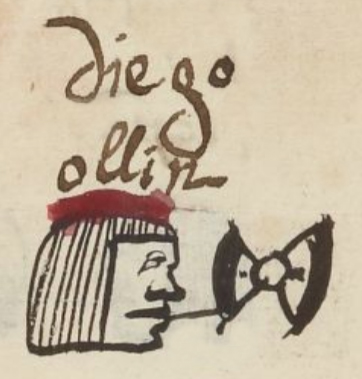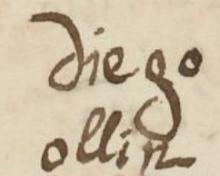Olin (MH499r)
This black-line drawing of the simplex glyph for the personal name Olin (here, attested as a man's name) is the sign for movement (olin). It is shaped like a large X with a circle in the middle. On the right and left, thick black curving lines connect the legs of the X. Inside those curving, thick lines--in the white space they create--are additional black marks.
Stephanie Wood
This sign, a day name in the 260-day calendar called the tonalpohualli, is meant to convey movement visually, as it draws the eye back and forth. The style of this sign varies considerably from tlacuilo to tlacuilo across this collection, sometimes combining with olli, rubber, but such is not obvious in this case. A few examples appear below.
Stephanie Wood
diego
ollin
Diego Olin
Stephanie Wood
1560
Jeff Haskett-Wood
movement, movimiento, nombres de hombres

ol(in), movement or earthquake, https://nahuatl.wired-humanities.org/content/olin
Movimiento, o Temblor
Stephanie Wood
Matrícula de Huexotzinco, folio 499r, World Digital Library, https://www.loc.gov/resource/gdcwdl.wdl_15282/?sp=77&st=image
This manuscript is hosted by the Library of Congress and the World Digital Library; used here with the Creative Commons, “Attribution-NonCommercial-ShareAlike 3.0 License” (CC-BY-NC-SAq 3.0).








